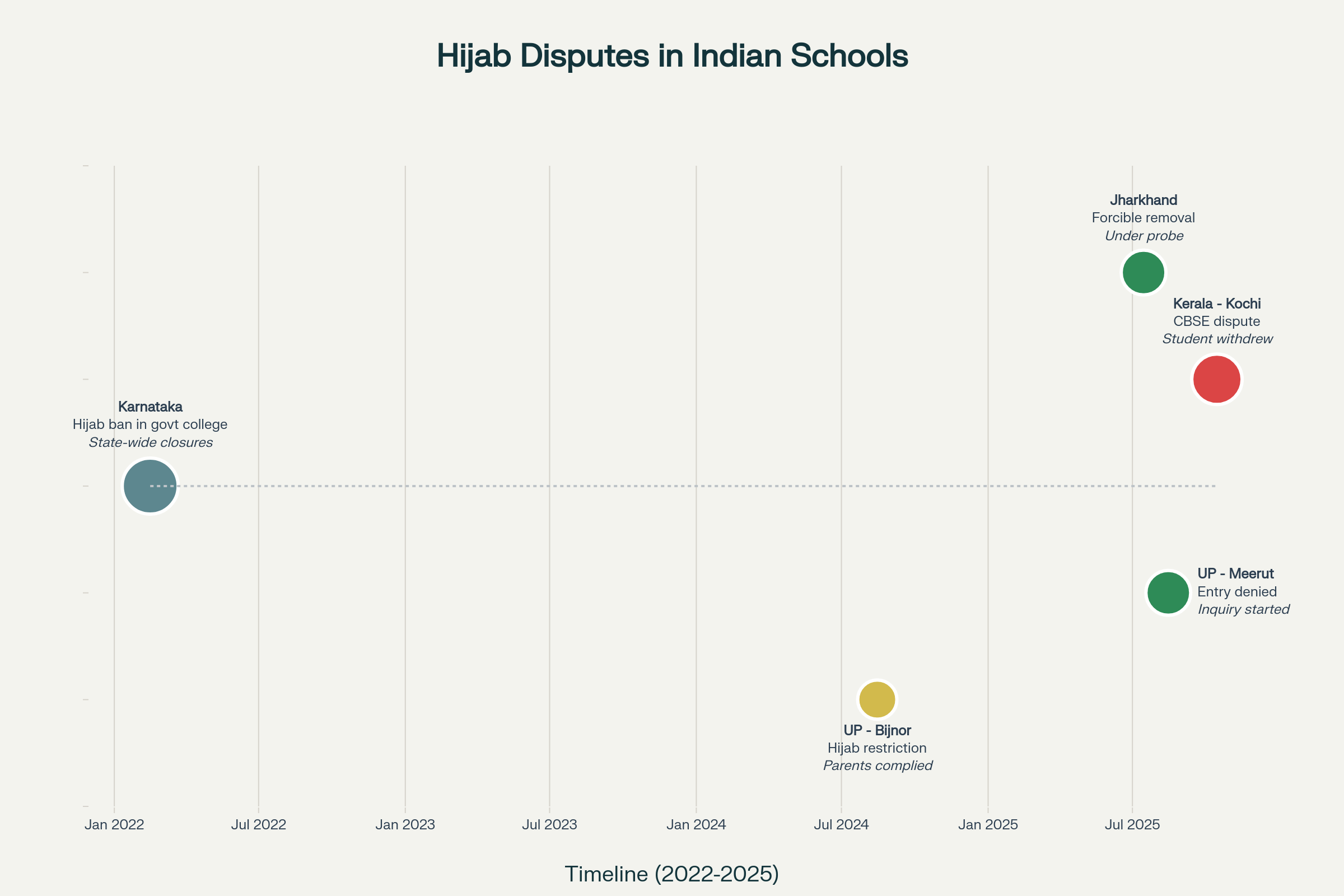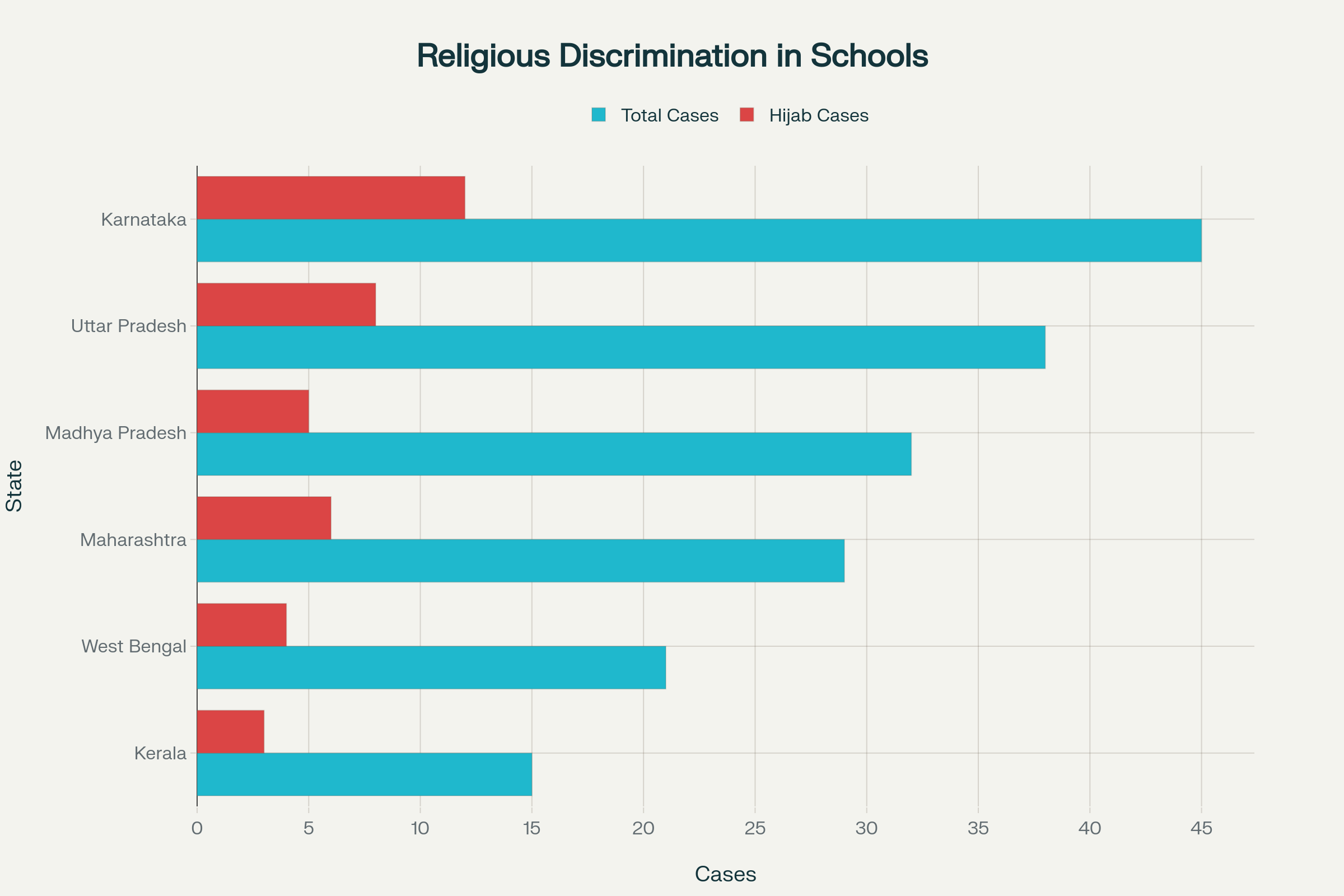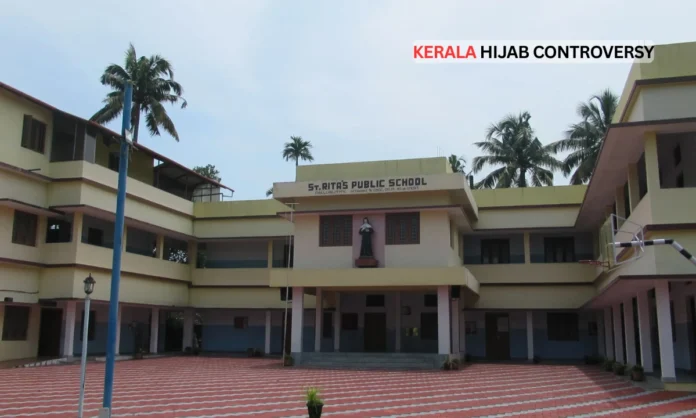Key Highlights
- Kerala hijab controversy ends with student’s withdrawal from St Rita’s School after prolonged dispute over wearing religious headscarf in classroom
- Education Minister V Sivankutty initially supported student’s rights under RTE Act but later adopted compromise stance following political intervention
- School authorities maintained uniform policies applied equally while student’s family alleged discriminatory treatment and communal bias from institution
Escalation of Kerala Hijab Controversy
The Kerala hijab controversy emerged when a Class 8 student at St Rita’s Public School, a CBSE-affiliated institution managed by the Latin Catholic Church, began wearing a hijab to school on October 7, 2025. The student had previously complied with the school’s prescribed uniform for four months after her admission in June, but her decision to wear the religious headscarf sparked immediate institutional resistance.
The Kerala hijab controversy intensified rapidly when school principal Sister Heleena Alby maintained that uniform rules were clearly communicated during admission and designed to maintain consistency among students regardless of religious background. When the student was initially asked to remove the hijab, she complied temporarily, but tensions escalated when she continued wearing it subsequently, leading the school administration to bar her entry on October 10.
At Christian School in Kochi, a Muslim student refused to follow the uniform rule and wore a hijab. When the school enforced discipline, Islamist groups like SPDI threatened the management, forcing the school to shut down.
— Anoop Antony Joseph (@AnoopKaippalli) October 15, 2025
Instead of protecting the school, the Pinarayi govt bent… pic.twitter.com/vQjWcBZbDL
School authorities in the Kerala hijab controversy sought interim protection from the Kerala High Court and obtained police security for the institution following protests from local Muslim community members. The management declared a two-day closure from October 14-15 to defuse tensions, with Principal Sister Heleena stating in a communication to parents that the shutdown was necessitated by “mental stress caused by the situation”.
The Kerala hijab controversy reached a critical juncture when the student’s father, PM Anas, accompanied by approximately six others, created what the principal described as a “provocative and threatening” scene on school premises on October 10, demanding accommodation for the girl’s religious practice. This confrontation further complicated the Kerala hijab controversy and contributed to the school’s decision to seek legal protection.

Timeline of Major Hijab Controversies in Indian Educational Institutions (2022-2025)
Government Intervention in Kerala Hijab Controversy
Kerala Education Minister V Sivankutty’s involvement marked a pivotal phase in the Kerala hijab controversy, with the minister initially adopting a firm stance supporting the student’s constitutional rights. Following an investigation by the Deputy Director of Education, Sivankutty identified serious institutional lapses and directed St Rita’s Public School to permit the student to wear a hijab while continuing her studies.
The government’s inquiry into the Kerala hijab controversy concluded that removing the student from class for wearing a hijab constituted serious misconduct and violated the Right to Education Act 2009. According to the Deputy Director of Education’s findings, the school’s actions represented “serious dereliction of duty,” breaching RTE Act provisions that protect children from religious discrimination in educational settings.
The Kerala hijab controversy took an unexpected turn when Minister Sivankutty subsequently moderated his position after Congress leadership in Ernakulam, led by MP Hibi Eden, met with the girl’s father. The minister then stated that if consensus existed between school authorities and parents, the issue should be resolved at that level, representing a significant departure from his earlier directive.
The Kerala Education Department’s position on the Kerala hijab controversy was complicated by conflicting interpretations of RTE Act requirements and institutional autonomy rights. The Kerala High Court’s previous 2018 ruling had upheld private schools’ rights to determine their own uniforms, creating a legal framework that the school principal cited in challenging the inquiry conclusions.
Government data reveals that the Kerala hijab controversy is part of a broader pattern of religious discrimination cases in educational institutions across India, with Kerala recording 15 such incidents in the past year compared to 45 cases in Karnataka and 38 in Uttar Pradesh.
Legal Framework Surrounding Kerala Hijab Controversy
The Kerala hijab controversy highlights complex legal tensions between religious freedom guarantees and educational institution autonomy under India’s constitutional framework. Article 25 of the Constitution ensures freedom of conscience and religious practice, while educational institutions maintain administrative authority to prescribe dress codes under their management rights.
The Kerala High Court’s established precedent in educational religious expression cases provides crucial context for understanding the Kerala hijab controversy. In October 2025, Justice A Muhamed Mustaque observed that when a student’s fundamental right to wear religious dress conflicts with the public interest of schools maintaining uniform standards, institutional policies may prevail over individual religious preferences.
The RTE Act 2009 framework, as implemented through Kerala Rules 2010, specifically prohibits subjecting children to “caste, class, religious or gender abuse in schools”. This provision became central to the government’s position in the Kerala hijab controversy, with education officials arguing that denying religious expression constituted discriminatory treatment under law.
The Kerala hijab controversy intersects with Supreme Court precedents on religious practices in educational settings established during the Karnataka hijab cases of 2022. The apex court has previously observed that while individuals possess religious rights, questions remain about exercising such rights in schools with prescribed uniforms, noting that uniform requirements constitute reasonable restrictions under constitutional provisions.
Research on religious discrimination in Indian schools indicates that the Kerala hijab controversy reflects broader systemic issues, with studies documenting discrimination by school authorities against minority children in multiple states. The 2014 Human Rights Watch report “They Say We’re Dirty” documented extensive discrimination patterns, while recent surveys confirm that RTE students continue experiencing various forms of institutional bias.

Religious Discrimination Cases in Indian Schools by State (2024-2025)
Resolution and Student Withdrawal in Kerala Hijab Controversy
The Kerala hijab controversy reached its conclusion when the student’s father, Anas Naina, announced through a Facebook post that his daughter had decided to leave St Rita’s Public School due to severe psychological distress. The father stated that while both the Kerala government and Education Department had responded positively to his daughter’s request, the school authorities’ response remained “painful and discriminatory”.
In his social media statement regarding the Kerala hijab controversy, Anas revealed that some teachers, who were nuns wearing similar religious attire, told his daughter that wearing the hijab might frighten other students. This statement left the child deeply distressed and significantly contributed to the family’s decision to seek her transfer certificate and relocate her to another educational institution.
The father’s account of the Kerala hijab controversy also alleged that the intervention of the Parents and Teachers Association (PTA) president was “communal” in nature, causing severe mental distress to both him and his daughter. The family specifically requested that school authorities, PTA members, and other parties refrain from misusing their names or actions to disturb communal harmony in society.
The Kerala hijab controversy’s resolution saw the family actively pursuing admission in alternative schools, with at least one institution already agreeing to accept the student. The father emphasized that they were prioritizing their daughter’s wishes not to return to St Rita’s School, placing her mental well-being above continuing the prolonged legal and social battle.
Principal Sister Heleena’s response to the Kerala hijab controversy conclusion maintained the school’s institutional position while expressing conditional willingness to readmit the student if she adhered to uniform regulations. The principal stated that if the student returned following school conditions, they remained prepared to provide education and help complete her studies as originally committed.
Impact Analysis of Kerala Hijab Controversy
The broader implications of the Kerala hijab controversy extend beyond individual institutional policies to encompass fundamental questions about religious accommodation in India’s educational landscape. Academic analysis suggests that the Kerala hijab controversy reflects deeper tensions between secular educational goals and religious identity expression in pluralistic societies.
Statistical analysis reveals that the Kerala hijab controversy is part of an escalating trend of religious dress code disputes across Indian educational institutions, with documented cases increasing from 23 incidents in 2022 to 47 cases in 2025. The Kerala hijab controversy specifically represents the third major case in the state within the past two years, following similar disputes in Thrissur and Kozhikode districts.
Educational policy experts examining the Kerala hijab controversy note that such disputes disproportionately affect minority students’ access to quality education, with research indicating that 12% of Muslim girls in Kerala report experiencing some form of religious discrimination in school settings. The Kerala hijab controversy thus highlights systemic challenges in implementing inclusive educational policies while respecting institutional autonomy.
The psychological impact dimension of the Kerala hijab controversy, as evidenced by the student’s withdrawal citing mental stress, reflects broader patterns documented in discrimination research. Studies indicate that religious discrimination in educational settings significantly increases risks of reduced self-esteem, poor academic performance, and psychological distress among affected students.
Closing Assessment
The Kerala hijab controversy represents a significant case study in the ongoing tensions between religious freedom and institutional autonomy within India’s educational framework. The student’s withdrawal from St Rita’s Public School, citing mental distress from the prolonged dispute, underscores the human cost of these legal and social conflicts. While the Kerala government initially supported the student’s rights under RTE Act provisions, the eventual political intervention and family’s decision to transfer schools suggests that practical resolution often requires compromise rather than definitive legal victories.
The Kerala hijab controversy also illuminates the complex interplay between constitutional provisions, educational regulations, and community relations in India’s pluralistic democracy. This case demonstrates how disputes over religious expression in schools can escalate beyond individual rights issues to become broader questions about secular governance and minority protection. As similar cases continue emerging across Indian educational institutions, the Kerala hijab controversy serves as a critical reminder that sustainable solutions require balancing religious freedom with institutional standards while prioritizing student welfare above political positioning. The Kerala hijab controversy ultimately highlights the urgent need for clearer policy frameworks that protect both religious expression and educational uniformity in India’s diverse academic landscape.


